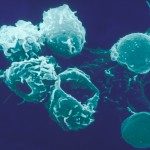Link to Pubmed [PMID] – 24041595
Blood Cells Mol. Dis. 2013 Dec;51(4):226-31
Blood cells are continually produced from a pool of progenitors that derive from hematopoietic stem cells (HSCs). In vertebrates, the hematopoietic system develops from two distinct waves or generation of precursors. The first wave occurs in the yolk sac, in mammals or equivalent embryonic structure, and produces nucleated primitive erythrocytes that provide the embryo with the first oxygen transporter and are, therefore, essential for the viability of the embryo. The yolk sac also produces myeloid cells that migrate to the central nervous system and to the skin to form the microglia and skin specific macrophages, the Langerhans cells. The second wave occurs in the dorsal aorta and produces multipotential hematopoietic progenitors. These cells are generated once in the lifetime from mesoderm derivatives closely related to endothelial cells, during a short period of embryonic development. Newly generated cells do not reconstitute the hematopoietic compartment of conventional recipients; therefore, they are designated as immature or pre-HSCs. They undergo maturation into adult HSCs in the aorta or in the fetal liver accompanied by the expression of MHC class I, CD45, CD150, Sca-1 and the absence of CD48. Differentiation of HSCs first occurs in the fetal liver, giving rise to mature blood cells. HSCs also expand in the fetal liver, and in a short time period (four days in the mouse embryo), they increase over 40-fold. HSCs and progenitor cells exit the fetal liver and colonize the spleen, where differentiation to the myeloid lineage and particular lymphoid subsets is favored.


